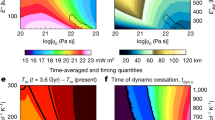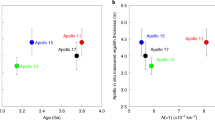Abstract
The origin of the Martian moons, Phobos and Deimos, remains elusive. While the morphology and their cratered surfaces suggest an asteroidal origin1,2,3, capture has been questioned because of potential dynamical difficulties in achieving the current near-circular, near-equatorial orbits4,5. To circumvent this, in situ formation models have been proposed as alternatives6,7,8,9. Yet, explaining the present location of the moons on opposite sides of the synchronous radius, their small sizes and apparent compositional differences with Mars2 has proved challenging. Here, we combine geophysical and tidal-evolution modelling of a Mars–satellite system to propose that Phobos and Deimos originated from disintegration of a common progenitor that was possibly formed in situ. We show that tidal dissipation within a Mars–satellite system, enhanced by the physical libration of the satellite, circularizes the post-disrupted eccentric orbits in <2.7 Gyr and makes Phobos descend to its present orbit from its point of origin close to or above the synchronous orbit. Our estimate for Phobos’s maximal tidal lifetime is considerably less than the age of Mars, indicating that it is unlikely to have originated alongside Mars. Deimos initially moved inwards, but never transcended the co-rotation radius because of insufficient eccentricity and therefore insufficient tidal dissipation. Whereas Deimos is very slowly receding from Mars, Phobos will continue to spiral towards and either impact with Mars or become tidally disrupted on reaching the Roche limit in ≲39 Myr.
This is a preview of subscription content, access via your institution
Access options
Access Nature and 54 other Nature Portfolio journals
Get Nature+, our best-value online-access subscription
$29.99 / 30 days
cancel any time
Subscribe to this journal
Receive 12 digital issues and online access to articles
$119.00 per year
only $9.92 per issue
Buy this article
- Purchase on Springer Link
- Instant access to full article PDF
Prices may be subject to local taxes which are calculated during checkout

Similar content being viewed by others
Data availability
The data that support the findings of this study are available from the corresponding author on request.
Code availability
The code for computing the orbital evolution is available on request from the corresponding author.
References
Rosenblatt, P. The origin of the Martian moons revisited. Astron. Astrophys. Rev. 19, 44 (2011).
Pajola, M. et al. Phobos as a D-type captured asteroid, spectral modeling from 0.25 to 4.0 μm. Astron. J. 777, 127 (2013).
Fraeman, A. et al. Spectral absorptions on Phobos and Deimos in the visible/near infrared wavelengths and their compositional constraints. Icarus 229, 196–205 (2014).
Lambeck, K. On the orbital evolution of the Martian satellites. J. Geophys. Res. Planets 84, 5651–5658 (1979).
Szeto, A. M. Orbital evolution and origin of the Martian satellites. Icarus 55, 133–168 (1983).
Craddock, R. A. Are Phobos and Deimos the result of a giant impact? Icarus 211, 1150–1161 (2011).
Citron, R. I., Genda, H. & Ida, S. Formation of Phobos and Deimos via a giant impact. Icarus 252, 334–338 (2015).
Canup, R. & Salmon, J. Origin of Phobos and Deimos by the impact of a Vesta-to-Ceres sized body with Mars. Sci. Adv. 4, eaar6887 (2018).
Rosenblatt, P. et al. Accretion of Phobos and Deimos in an extended debris disc stirred by transient moons. Nat. Geosci. 9, 581–583 (2016).
Efroimsky, M. & Lainey, V. Physics of bodily tides in terrestrial planets and the appropriate scales of dynamical evolution. J. Geophys. Res. Planets 112, E12003 (2007).
Lognonné, P. et al. Constraints on the shallow elastic and anelastic structure of Mars from InSight seismic data. Nat. Geosci. 13, 213–220 (2020).
Giardini, D. et al. The seismicity of Mars. Nat. Geosci. 13, 205–212 (2020).
Jackson, I. & Faul, U. H. Grainsize-sensitive viscoelastic relaxation in olivine: towards a robust laboratory-based model for seismological application. Phys. Earth Planet. Inter. 183, 151–163 (2010).
Bagheri, A., Khan, A., Al-Attar, D., Crawford, O. & Giardini, D. Tidal response of Mars constrained from laboratory-based viscoelastic dissipation models and geophysical data. J. Geophys. Res. Planets 124, 2703–2727 (2019).
Efroimsky, M. Bodily tides near spin–orbit resonances. Celest. Mech. Dyn. Astron. 112, 283–330 (2012).
Rambaux, N., Castillo-Rogez, J., Le Maistre, S. & Rosenblatt, P. Rotational motion of Phobos. Astron. Astrophys. 548, A14 (2012).
Yoder, C. F. Tidal rigidity of Phobos. Icarus 49, 327–346 (1982).
Khan, A. et al. A geophysical perspective on the bulk composition of Mars. J. Geophys. Res. Planets 123, 575–611 (2018).
Pätzold, M. et al. Phobos mass determination from the very close flyby of Mars Express in 2010. Icarus 229, 92–98 (2014).
Brasser, R. Efficient tidal dissipation in Deimos. Icarus 347, 113791 (2020).
Hurford, T. et al. Tidal disruption of Phobos as the cause of surface fractures. J. Geophys. Res. Planets 121, 1054–1065 (2016).
Asphaug, E., Ostro, S. J., Hudson, R., Scheeres, D. J. & Benz, W. Disruption of kilometre-sized asteroids by energetic collisions. Nature 393, 437–440 (1998).
Nimmo, F. & Matsuyama, I. Tidal dissipation in rubble-pile asteroids. Icarus 321, 715–721 (2019).
Wisdom, J. Rotational dynamics of irregularly shaped natural satellites. Astron. J. 94, 1350–1360 (1987).
Quillen, A. C., Lane, M., Nakajima, M. & Wright, E. Excitation of tumbling in Phobos and Deimos. Icarus 340, 113641 (2020).
Simioni, E., Pajola, M., Massironi, M. & Cremonese, G. Phobos grooves and impact craters: a stereographic analysis. Icarus 256, 90–100 (2015).
Jutzi, M. & Benz, W. Formation of bi-lobed shapes by sub-catastrophic collisions—a late origin of comet 67P’s structure. Astron. Astrophys. 597, A62 (2017).
Singer, S. F. Origin of the Martian satellites Phobos and Deimos. In Proc. 1st International Conference on the Exploration of Phobos and Deimos LPI Contribution No. 1377, 36 (Lunar and Planetary Institute, 2007).
Hesselbrock, A. J. & Minton, D. A. An ongoing satellite–ring cycle of Mars and the origins of Phobos and Deimos. Nat. Geosci. 10, 266–269 (2017).
Samuel, H., Lognonné, P., Panning, M. & Lainey, V. The rheology and thermal history of Mars revealed by the orbital evolution of Phobos. Nature 569, 523–527 (2019).
Black, B. & Mittal, T. The demise of Phobos and development of a Martian ring system. Nat. Geosci. 8, 913–917 (2015).
Boué, G. & Efroimsky, M. Tidal evolution of the Keplerian elements. Celest. Mech. Dyn. Astron. 131, 30 (2019).
Acknowledgements
We thank G. Kaplan for comments on an earlier version of this manuscript and M. Jutzi for informed discussion on the topic of impact disruption. This work was supported by a grant from the Swiss National Science Foundation (SNSF project 172508 ‘Mapping the internal structure of Mars’). This is InSight contribution number 96.
Author information
Authors and Affiliations
Contributions
A.B., A.K. and M.E. discussed the original idea; A.B. derived and implemented the orbital evolution model, with input from M.E. and A.K.; M.K. helped with implementation of the numerical time-stepping scheme in the orbital evolution model; A.B. performed the simulations and data analysis and produced the figures; the manuscript was written by A.K., A.B., M.E. and M.K., with input from D.G.
Corresponding author
Ethics declarations
Competing interests
The authors declare no competing interests.
Additional information
Peer review information Nature Astronomy thanks Gwenaël Boué, Hidenori Genda and the other, anonymous, reviewer(s) for their contribution to the peer review of this work.
Publisher’s note Springer Nature remains neutral with regard to jurisdictional claims in published maps and institutional affiliations.
Supplementary information
Supplementary Information
Supplementary Sections 1–13, Figs. 1–10 and Tables 1–8.
Rights and permissions
About this article
Cite this article
Bagheri, A., Khan, A., Efroimsky, M. et al. Dynamical evidence for Phobos and Deimos as remnants of a disrupted common progenitor. Nat Astron 5, 539–543 (2021). https://doi.org/10.1038/s41550-021-01306-2
Received:
Accepted:
Published:
Issue Date:
DOI: https://doi.org/10.1038/s41550-021-01306-2
This article is cited by
-
Sputnik Planitia as an impactor remnant indicative of an ancient rocky mascon in an oceanless Pluto
Nature Astronomy (2024)
-
Evidence for lunar tide effects in Earth’s plasmasphere
Nature Physics (2023)
-
The Origins and Geological Histories of Deimos and Phobos: Hypotheses and Open Questions
Space Science Reviews (2021)



